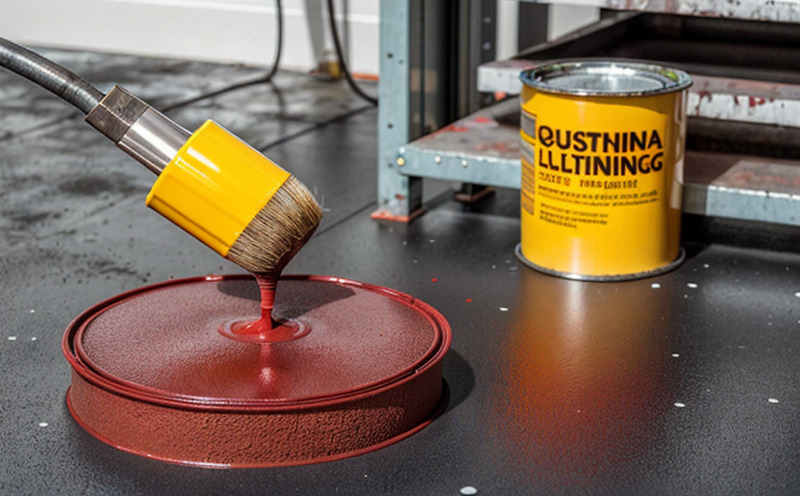ISO 2813 Gloss Measurement Testing of Paints Validation Method Development Test
The ISO 2813 standard specifies a method for measuring the specular gloss of paints, varnishes, and similar materials. This test is particularly crucial in industrial manufacturing and processing where surface finish quality directly impacts the performance and aesthetic appeal of products. Understanding how to validate methods using this standard allows quality managers, compliance officers, R&D engineers, and procurement teams to ensure that their processes meet international standards.
The process involves several key steps, including specimen preparation, choice of appropriate measurement geometry (0°-180°), and the use of a gloss meter. Specimen preparation is critical; it ensures that the surface is homogeneous and free from defects. The choice of measurement geometry depends on the intended use of the product. For instance, automotive paints may require higher geometric angles to simulate real-world conditions.
The gloss meter used in this test must comply with ISO 2813 standards. It measures specular reflectance under controlled light sources and viewing angles. Specimens are typically prepared as flat panels or small disks, depending on the product being tested. Once prepared, they undergo measurement according to the specified conditions.
The validation process involves comparing new methods against established ones using ISO 2813. This comparison helps identify any discrepancies that might arise from changes in equipment calibration, environmental factors, or procedural variations. By validating methods, manufacturers can ensure consistency across production batches and locations. This is essential for maintaining brand reputation and regulatory compliance.
Real-world applications of this testing are vast. In automotive manufacturing, consistent gloss measurement ensures uniform paint finish quality, enhancing vehicle appearance and durability. In aerospace coatings, precise gloss control is vital to prevent glare and improve visibility under various lighting conditions. In the construction industry, high-gloss finishes can enhance aesthetic appeal while providing protection against environmental elements.
To perform this test effectively, it’s important to have a well-equipped laboratory with state-of-the-art equipment like advanced spectrophotometers and experienced technicians who understand both theory and practice. Regular calibration of instruments ensures accurate results, which is crucial for reliable validation.
The importance of this testing cannot be overstated; improper gloss measurement can lead to subpar product quality, increased costs due to rework or recalls, and damaged reputation. By adhering strictly to ISO 2813 standards, industrial manufacturers can maintain high-quality outputs that meet customer expectations and regulatory requirements.
Understanding the intricacies of this test is key for those involved in specifying materials, developing processes, and ensuring quality control. Knowledgeable personnel can leverage these insights to innovate within their fields, driving efficiency and excellence through precise measurement techniques.
- Benefits: Improved consistency across batches; enhanced product performance; reduced rework; better alignment with international standards.
- Competitive Advantage: Consistent quality control; reduced risk of non-compliance issues; ability to introduce new products more confidently.
Applied Standards
The ISO 2813 standard is widely recognized for its accuracy and reliability in measuring specular gloss. It applies specifically to paints, varnishes, lacquers, and similar materials used in various industrial applications. This method ensures that all measurements are consistent, regardless of the location or equipment being used.
Other standards related to surface finish testing include ASTM D2486 for paint gloss measurement using a 60° geometry, which is often used alongside ISO 2813 for comprehensive evaluations. EN 778 provides guidance on color and appearance measurements in the paint industry, complementing ISO 2813 when broader color attributes need to be considered.
For industrial applications where specific environmental factors influence surface finish performance, additional standards like ASTM D4059 might also be relevant. These standards collectively form a robust framework for ensuring that all aspects of surface finish quality are accounted for during testing and validation processes.
Competitive Advantage and Market Impact
Adhering to ISO 2813 can provide significant advantages in the competitive market. Consistent gloss measurement ensures that products meet customer expectations, thereby fostering trust and loyalty. This consistency also reduces costs associated with rework or recalls due to quality issues.
In terms of market impact, compliance with international standards like ISO 2813 can open doors to new markets where regulatory requirements are stringent. It demonstrates a commitment to excellence that can attract more customers and partners. Additionally, by innovating within this framework, companies can introduce new products more confidently, knowing they meet rigorous quality benchmarks.
For R&D teams specifically, mastering ISO 2813 allows for the development of more efficient processes and materials. This expertise can lead to breakthroughs in surface finish technology that set a company apart from competitors. Furthermore, it enables better collaboration with regulatory bodies, ensuring products are always up-to-date with changing requirements.
Overall, adherence to ISO 2813 contributes significantly to both competitive positioning and market success by fostering trust among consumers and stakeholders while driving innovation within the industry.
- Competitive Advantage: Consistent quality control; reduced risk of non-compliance issues; ability to introduce new products more confidently.
- Market Impact: Increased customer satisfaction; enhanced reputation for reliability; easier entry into international markets with stringent regulatory requirements.





